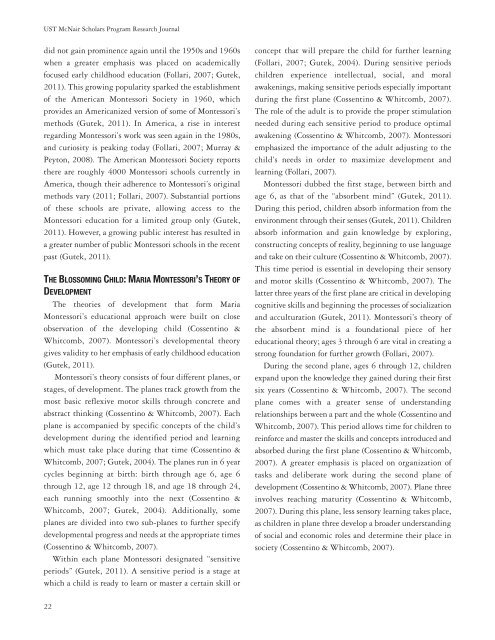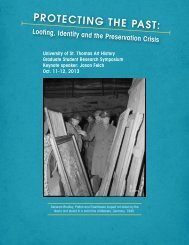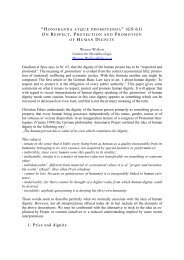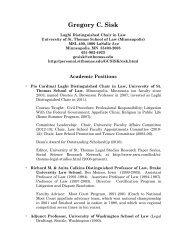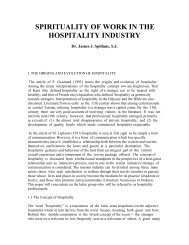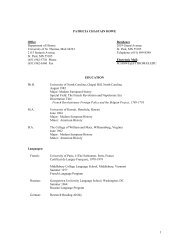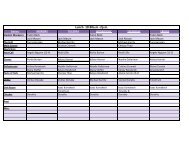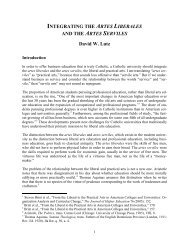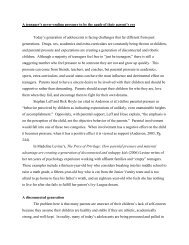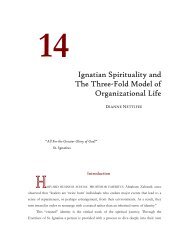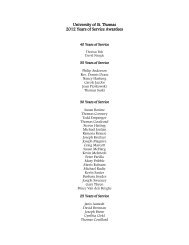dr. ronald e. mcnair acknowledgements - University of St. Thomas
dr. ronald e. mcnair acknowledgements - University of St. Thomas
dr. ronald e. mcnair acknowledgements - University of St. Thomas
You also want an ePaper? Increase the reach of your titles
YUMPU automatically turns print PDFs into web optimized ePapers that Google loves.
UST McNair Scholars Program Research Journal<br />
did not gain prominence again until the 1950s and 1960s<br />
when a greater emphasis was placed on academically<br />
focused early childhood education (Follari, 2007; Gutek,<br />
2011). This growing popularity sparked the establishment<br />
<strong>of</strong> the American Montessori Society in 1960, which<br />
provides an Americanized version <strong>of</strong> some <strong>of</strong> Montessori’s<br />
methods (Gutek, 2011). In America, a rise in interest<br />
regarding Montessori’s work was seen again in the 1980s,<br />
and curiosity is peaking today (Follari, 2007; Murray &<br />
Peyton, 2008). The American Montessori Society reports<br />
there are roughly 4000 Montessori schools currently in<br />
America, though their adherence to Montessori’s original<br />
methods vary (2011; Follari, 2007). Substantial portions<br />
<strong>of</strong> these schools are private, allowing access to the<br />
Montessori education for a limited group only (Gutek,<br />
2011). However, a growing public interest has resulted in<br />
a greater number <strong>of</strong> public Montessori schools in the recent<br />
past (Gutek, 2011).<br />
THE BLOSSOMING CHILD: MARIA MONTESSORI’S THEORY OF<br />
DEVELOPMENT<br />
The theories <strong>of</strong> development that form Maria<br />
Montessori’s educational approach were built on close<br />
observation <strong>of</strong> the developing child (Cossentino &<br />
Whitcomb, 2007). Montessori’s developmental theory<br />
gives validity to her emphasis <strong>of</strong> early childhood education<br />
(Gutek, 2011).<br />
Montessori’s theory consists <strong>of</strong> four different planes, or<br />
stages, <strong>of</strong> development. The planes track growth from the<br />
most basic reflexive motor skills through concrete and<br />
abstract thinking (Cossentino & Whitcomb, 2007). Each<br />
plane is accompanied by specific concepts <strong>of</strong> the child’s<br />
development during the identified period and learning<br />
which must take place during that time (Cossentino &<br />
Whitcomb, 2007; Gutek, 2004). The planes run in 6 year<br />
cycles beginning at birth: birth through age 6, age 6<br />
through 12, age 12 through 18, and age 18 through 24,<br />
each running smoothly into the next (Cossentino &<br />
Whitcomb, 2007; Gutek, 2004). Additionally, some<br />
planes are divided into two sub-planes to further specify<br />
developmental progress and needs at the appropriate times<br />
(Cossentino & Whitcomb, 2007).<br />
Within each plane Montessori designated “sensitive<br />
periods” (Gutek, 2011). A sensitive period is a stage at<br />
which a child is ready to learn or master a certain skill or<br />
22<br />
concept that will prepare the child for further learning<br />
(Follari, 2007; Gutek, 2004). During sensitive periods<br />
chil<strong>dr</strong>en experience intellectual, social, and moral<br />
awakenings, making sensitive periods especially important<br />
during the first plane (Cossentino & Whitcomb, 2007).<br />
The role <strong>of</strong> the adult is to provide the proper stimulation<br />
needed during each sensitive period to produce optimal<br />
awakening (Cossentino & Whitcomb, 2007). Montessori<br />
emphasized the importance <strong>of</strong> the adult adjusting to the<br />
child’s needs in order to maximize development and<br />
learning (Follari, 2007).<br />
Montessori dubbed the first stage, between birth and<br />
age 6, as that <strong>of</strong> the “absorbent mind” (Gutek, 2011).<br />
During this period, chil<strong>dr</strong>en absorb information from the<br />
environment through their senses (Gutek, 2011). Chil<strong>dr</strong>en<br />
absorb information and gain knowledge by exploring,<br />
constructing concepts <strong>of</strong> reality, beginning to use language<br />
and take on their culture (Cossentino & Whitcomb, 2007).<br />
This time period is essential in developing their sensory<br />
and motor skills (Cossentino & Whitcomb, 2007). The<br />
latter three years <strong>of</strong> the first plane are critical in developing<br />
cognitive skills and beginning the processes <strong>of</strong> socialization<br />
and acculturation (Gutek, 2011). Montessori’s theory <strong>of</strong><br />
the absorbent mind is a foundational piece <strong>of</strong> her<br />
educational theory; ages 3 through 6 are vital in creating a<br />
strong foundation for further growth (Follari, 2007).<br />
During the second plane, ages 6 through 12, chil<strong>dr</strong>en<br />
expand upon the knowledge they gained during their first<br />
six years (Cossentino & Whitcomb, 2007). The second<br />
plane comes with a greater sense <strong>of</strong> understanding<br />
relationships between a part and the whole (Cossentino and<br />
Whitcomb, 2007). This period allows time for chil<strong>dr</strong>en to<br />
reinforce and master the skills and concepts introduced and<br />
absorbed during the first plane (Cossentino & Whitcomb,<br />
2007). A greater emphasis is placed on organization <strong>of</strong><br />
tasks and deliberate work during the second plane <strong>of</strong><br />
development (Cossentino & Whitcomb, 2007). Plane three<br />
involves reaching maturity (Cossentino & Whitcomb,<br />
2007). During this plane, less sensory learning takes place,<br />
as chil<strong>dr</strong>en in plane three develop a broader understanding<br />
<strong>of</strong> social and economic roles and determine their place in<br />
society (Cossentino & Whitcomb, 2007).


